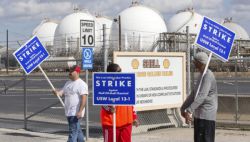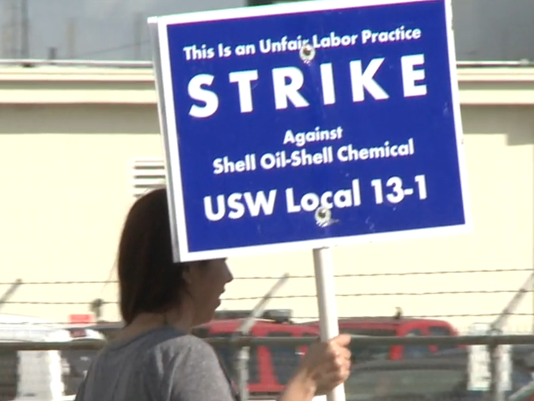On February 1, 3,800 workers walked out of 9 oil producing facilities in the US. In the past three weeks, the strike has spread to 6 additional plants, including the Motiva Enterprises refinery in Port Arthur, Texas, which has a crude capacity of 600,000 barrels a day, the largest of its kind in the country. The strike now involves 6,550 workers, at plants accounting for 20% of the country’s refining capacity. This is the largest walkout since 1980, and there is the possibility of it spreading to more workplaces.
Represented by the United Steelworkers (USW), the oil workers are demanding higher wages and an end to unsafe working conditions—the daily fires, leaks, emissions, and explosions which threaten not only the lives of refinery workers, but of entire neighborhoods surrounding the facilities. This is only worsened by contracting companies who hire non-unionized workers, further endangering conditions by limiting the number of workers on duty and demanding that they work overtime. 12-hour shifts lasting up to 2 weeks at a time result in fatigued workers who are six times more likely to die on the job than the average American. It is also a blatant attempt to break the power of the union by aiming to allow non-union contractors to take over key aspects of the work at the refineries.
 The strike was called by the USW after a contract negotiation dispute with Shell, which is representing all oil companies involved, including ExxonMobil, BP, and Tesoro. It is clear to the workers that Big Oil has no interest in their safety, wages, or benefits. They seek to minimize the number of workers at each plant, forcing them to work longer hours for lower pay, putting their lives at risk in the interest of even greater profits in one of the most historically lucrative industries in the world.
The strike was called by the USW after a contract negotiation dispute with Shell, which is representing all oil companies involved, including ExxonMobil, BP, and Tesoro. It is clear to the workers that Big Oil has no interest in their safety, wages, or benefits. They seek to minimize the number of workers at each plant, forcing them to work longer hours for lower pay, putting their lives at risk in the interest of even greater profits in one of the most historically lucrative industries in the world.
Just four years ago, a Tesoro refinery exploded due to neglected inspections by management, killing seven workers, yet all criminal charges have been dropped. Instead, the company continued its dangerous policy of cutting corners on safety to keep up profits by cancelling an accident prevention program run by the union. Just last week there was another refinery explosion in Southern California, which injured four workers and raised the urgency of the current strike.
Safety is not just an issue concerning oil workers, but also affects those who live near the refineries and who are put at great risk by toxic leaks and emissions. A 2012 refinery fire at a Chevron plant in Richmond, California resulted in 15,000 local residents going to the hospital after inhaling toxic fumes.
The current strike is a natural reaction to years of declining standards of living and increased workplace accidents, in which the victims receive little or no compensation. The sharp decline in oil prices over the last few months means the companies will put even greater pressure on the workers as the industry tries to maintain its profits levels. The Economist predicts that if profits fall, the industry will have a funding gap of $70 billion a year, which they will inevitably try to recover by squeezing it from the workers.
The oil workers have responded by launching one of the most prolonged struggles in decades. However, there is a difference between the struggles of the last great wave of strikes and today. In the 1970s, the USW managed to win a 10% wage increase just by threatening to go on strike. But we are no longer living in a capitalist boom. In a period of acute capitalist crisis, the bosses will viciously resist any threat to their profits, and the labor movement must prepare to match them in militancy and audacity.
 The 6,500 workers currently on strike should be able to put a stop to one fifth of the country’s oil production. This shows the immense potential strength the working class has amassed through the development and concentration of industry. Unfortunately, most facilities have continued production as the companies have brought in skilled management, retirees, and other scabs to run them. One of the struck plants was already out of commission due to previously planned maintenance. With a glut of gasoline on the market the strike has so far not had much of an effect on broader public consciousness. The only way a strike can be effective is if production is brought to a halt and scabs are prevented from ensuring business continues as usual. The militancy seen by rank-and-file workers on the picket lines must be matched by the USW leadership, who have been elected by the workers to defend their interests, not the companies’. The attack on the refinery workers is proof positive that “what is good for the company” is not good for the workers!
The 6,500 workers currently on strike should be able to put a stop to one fifth of the country’s oil production. This shows the immense potential strength the working class has amassed through the development and concentration of industry. Unfortunately, most facilities have continued production as the companies have brought in skilled management, retirees, and other scabs to run them. One of the struck plants was already out of commission due to previously planned maintenance. With a glut of gasoline on the market the strike has so far not had much of an effect on broader public consciousness. The only way a strike can be effective is if production is brought to a halt and scabs are prevented from ensuring business continues as usual. The militancy seen by rank-and-file workers on the picket lines must be matched by the USW leadership, who have been elected by the workers to defend their interests, not the companies’. The attack on the refinery workers is proof positive that “what is good for the company” is not good for the workers!
 To truly bring the bosses to their knees, the entire refining industry must be brought to a halt and an energetic campaign of outreach to all workers, both union and nonunion, must be launched. To begin, a concerted appeal must be made to the rest of the USW oil workers in the country, who altogether have their hands on over 64% of US fuel production. If the workers hope to win, every component of the industry must be drawn into the struggle, from the shipping, rail, and trucking to the gas station attendants. All workers in the US are under attack by the bosses and thousands have been involved in disputes across the country in recent months. If linked together, the power of the workers would be multiplied many times over. Unfortunately, with no militant lead given by the labor leadership, most workers are disoriented and feel isolated, and are being picked off by the bosses one by one. Nonetheless, this situation will not last forever. At a certain stage, the example of one group of struggling workers or another will catch the broader working class’ imagination and the dam that has long held back the generalized manifestation of the class struggle will burst.
To truly bring the bosses to their knees, the entire refining industry must be brought to a halt and an energetic campaign of outreach to all workers, both union and nonunion, must be launched. To begin, a concerted appeal must be made to the rest of the USW oil workers in the country, who altogether have their hands on over 64% of US fuel production. If the workers hope to win, every component of the industry must be drawn into the struggle, from the shipping, rail, and trucking to the gas station attendants. All workers in the US are under attack by the bosses and thousands have been involved in disputes across the country in recent months. If linked together, the power of the workers would be multiplied many times over. Unfortunately, with no militant lead given by the labor leadership, most workers are disoriented and feel isolated, and are being picked off by the bosses one by one. Nonetheless, this situation will not last forever. At a certain stage, the example of one group of struggling workers or another will catch the broader working class’ imagination and the dam that has long held back the generalized manifestation of the class struggle will burst.
 The struggles we have seen in the past months—including the Black Lives Matter movement against racist police brutality— are part of a new wave of rising consciousness in the US. This is emerging despite the naysaying of those who claim American workers to be right-wing and ignorant. In every state in the union, workers are coming into conflict with the capitalists, who have no interest at heart other than their profits. The only way to guarantee high wages, a decent standard of living, to prevent workplace accidents, and put an end to environmental disasters is for workers to take control over the key levers of the economy, to be run democratically in the interests of the majority of society, starting with the nationalization of the oil industry. But to do this we need a bold and courageous union leadership that recognizes that the interests of the bosses are diametrically opposed to the interests of the workers, and our own political party, a party of the working class majority—a mass party of labor—armed with a socialist program.
The struggles we have seen in the past months—including the Black Lives Matter movement against racist police brutality— are part of a new wave of rising consciousness in the US. This is emerging despite the naysaying of those who claim American workers to be right-wing and ignorant. In every state in the union, workers are coming into conflict with the capitalists, who have no interest at heart other than their profits. The only way to guarantee high wages, a decent standard of living, to prevent workplace accidents, and put an end to environmental disasters is for workers to take control over the key levers of the economy, to be run democratically in the interests of the majority of society, starting with the nationalization of the oil industry. But to do this we need a bold and courageous union leadership that recognizes that the interests of the bosses are diametrically opposed to the interests of the workers, and our own political party, a party of the working class majority—a mass party of labor—armed with a socialist program.
